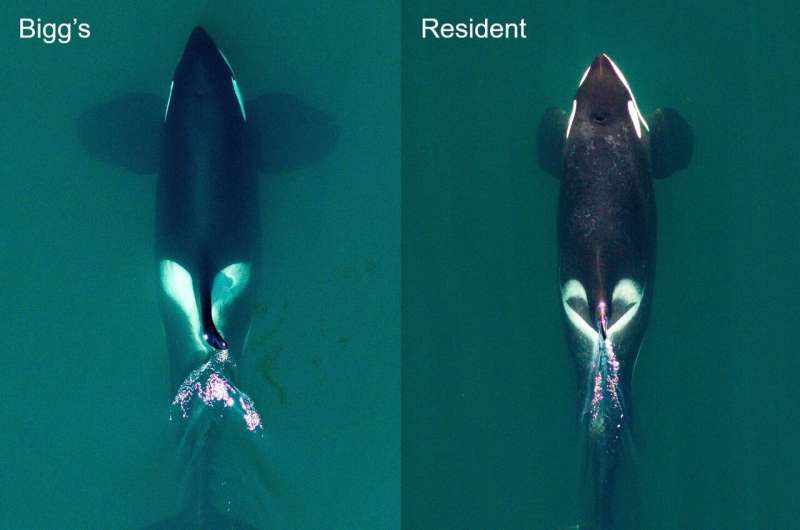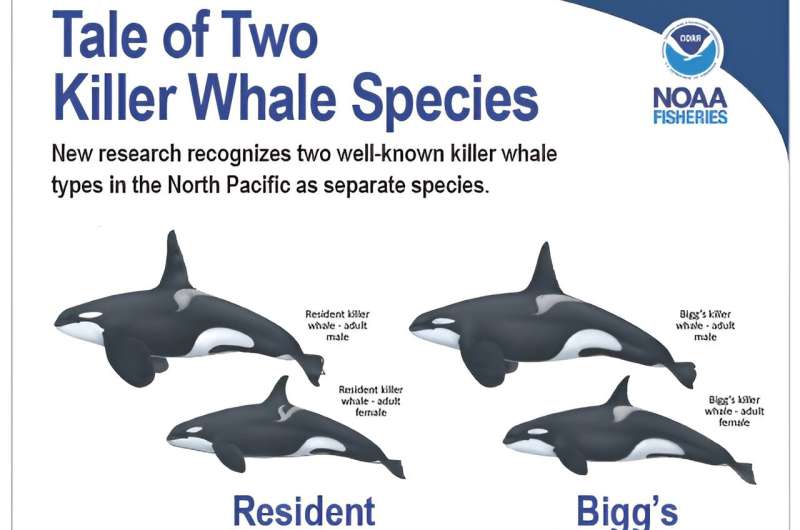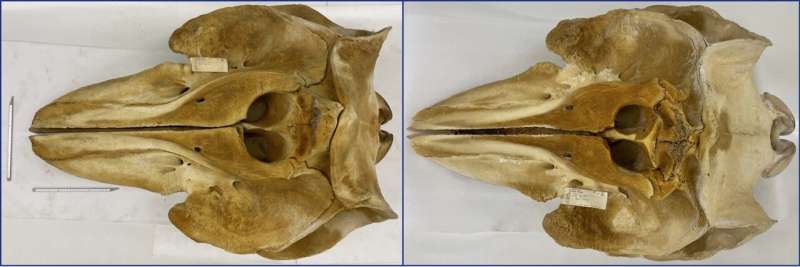This article has been reviewed according to Science X's editorial process and policies. Editors have highlighted the following attributes while ensuring the content's credibility:
fact-checked
peer-reviewed publication
trusted source
proofread
New research reveals full diversity of killer whales as two species come into view on Pacific Coast

Scientists have resolved one of the outstanding questions about one of the world's most recognizable creatures, identifying two well-known killer whales in the North Pacific Ocean as separate species. The research is published in the journal Royal Society Open Science.
Killer whales are one of the most widespread animals on Earth. They have long been considered one worldwide species known scientifically as Orcinus orca, with different forms in various regions known as "ecotypes."
However, biologists have increasingly recognized the differences between resident and Bigg's killer whales. Resident killer whales maintain tight-knit family pods and prey on salmon and other marine fish. Bigg's killer whales roam in smaller groups, preying on other marine mammals such as seals and whales. (Killer whales actually belong to the dolphin family.) Bigg's killer whales, sometimes called transients, are named for Canadian scientist Michael Bigg, the first to describe telltale differences between the two types.
He noted in the 1970s that the two animals did not mix with each other even as they occupied many of the same coastal waters, which is often a sign of different species.
The finding recognizes the accuracy of the listing of Southern Resident killer whales as a Distinct Population Segment warranting protection under the Endangered Species Act in 2005. At the time, NOAA described the distinct population segment as part of an unnamed subspecies of resident killer whales in the North Pacific.
Now a team of scientists from NOAA Fisheries and universities have assembled genetic, physical, and behavioral evidence. The data distinguish two of the killer whale ecotypes of the North Pacific Coast—residents and Bigg's—as separate species.
"We started to ask this question 20 years ago, but we didn't have much data, and we did not have the tools that we do now," said Phil Morin, an evolutionary geneticist at NOAA Fisheries' Southwest Fisheries Science Center and lead author of the new paper. "Now we have more of both, and the weight of the evidence says these are different species."

Genetic data from previous studies revealed that the two species likely diverged more than 300,000 years ago and come from opposite ends of the killer whale family tree. That makes them about as genetically different as any killer whale ecotypes around the globe. Subsequent studies of genomic data confirm that they have evolved as genetically and culturally distinct groups, which occupy different niches in the same Northwest marine ecosystem.
"They're the most different killer whales in the world, and they live right next to each other and see each other all the time," said Barbara Taylor, a former NOAA Fisheries marine mammal biologist who was part of the science panel that assessed the status of Southern Residents. "They just do not mix."
Recognizing new species
The Taxonomy Committee of the Society of Marine Mammalogy will determine whether to recognize the new species in its official list of marine mammal species. The committee will likely determine whether to accept the new designations at its next annual review this summer.
The scientists proposed scientific names for the new species based on their earliest published descriptions in the 1800s. Neither will keep the ubiquitous worldwide moniker, orca. The team proposed to call resident killer whales Orcinus ater, a Latin reference to their dominant black coloring. Bigg's killer whales would be called Orcinus rectipinnus, a combination of Latin words for erect wing, probably referring to their tall, sharp dorsal fin.
Both species names were originally published in 1869 by Edward Drinker Cope, a Pennsylvania scientist known more for unearthing dinosaurs than studying marine mammals. He was working from a manuscript that California whaling captain Charles Melville Scammon had sent to the Smithsonian Institution describing West Coast marine mammals, including the two killer whales. While Cope credited Scammon for the descriptions, Scammon took issue with Cope for editing and publishing Scammon's work without telling him. (See accompanying story.)
The Smithsonian Institution had shared Scammon's work with Cope, and a Smithsonian official later apologized to Scammon for what he called "Cope's absurd blunder."

Species reflect ecosystem
The contested question of whether Southern Residents were distinct enough to merit endangered species protections initially drove much of the research that helped differentiate the two species, said Eric Archer, who leads the Marine Mammal Genetics Program at the Southwest Fisheries Science Center and is a co-author of the new research paper.
The increasing processing power of computers has made it possible to examine killer whale DNA in ever finer detail. He said the findings not only validate protection for the animals themselves, but also help reveal different components of the marine ecosystems the whales depend on.
"As we better understand what makes these species special, we learn more about how they use the ecosystems they inhabit and what makes those environments special, too," he said.
The new research synthesizes the earliest accounts of killer whales on the Pacific Coast with modern data on physical characteristics. They also use aerial imaging (called photogrammetry), and measurement and genetic testing of museum specimens at the Smithsonian and elsewhere.
While the two species look similar to the untrained eye, the evidence demonstrates they are very different species. They use different ecological niches, such as specializing in different prey, said Kim Parsons, a geneticist at the NOAA Fisheries Northwest Fisheries Science Center in Seattle and co-author of the new research.
Recent research with drones and precise aerial photos has helped differentiate Bigg's killer whales as longer and larger. This might better equip them to go after large marine mammal prey. The smaller size of residents is likely better suited to deep dives after their salmon prey, said John Durban, an associate professor at Oregon State University's Marine Mammal Institute. He leads killer whale drone research with Holly Fearnbach, a researcher at SR³.
The different prey of the two species may also help explain their different trajectories. Southern Residents are listed as endangered in part because of the scarcity of their salmon prey. Bigg's killer whales, by contrast, have multiplied while feeding on plentiful marine mammals, including California sea lions.
While killer whales represent some of the most efficient predators the world has ever seen, Durban said science is still unraveling the diversity among them. The identification of additional killer whale species is likely to follow. One leading candidate may be "Type D" killer whales identified in the Southern Ocean around Antarctica.
Other killer whales in Antarctica also look very different from the best-known black and white killer whales. This reflects a wider diversity within the species, said Durban, who has used drones to study killer whales around the world. "The more we learn," he said, "the clearer it becomes to me that at least some of these types will be recognized as different species in due course."
More information: Phillip A. Morin et al, Revised taxonomy of eastern North Pacific killer whales (Orcinus orca ): Bigg's and resident ecotypes deserve species status, Royal Society Open Science (2024). DOI: 10.1098/rsos.231368
Journal information: Royal Society Open Science
Provided by NOAA Headquarters




















